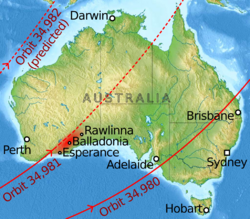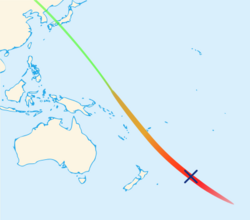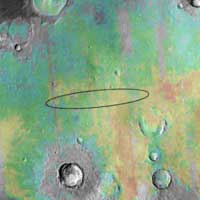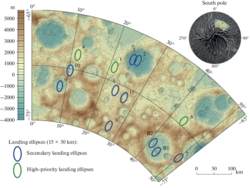Astronomy:List of landing ellipses on extraterrestrial bodies
From HandWiki

Shaded ellipses of Skylab's reentry on 1979-07-11. Included for purposes of comparison.

Deorbit of Mir, 23 March 2001. The debris field (in red) is ±1,500 x ±100 km, smaller than predicted due atmospheric reentry being slightly steeper than anticipated

The 150 x 20 km[1] landing footprint of Opportunity rover on Meridiani Planum, Mars in 2004

Suggested landing ellipses for Luna-25. Primary ellipses are 1, 4, 6 and secondary ellipses are 2, 3, 5, 7, 8, 9, 10, 11 and B1, B2.[2]
This is a list of the projected landing zones on extraterrestrial bodies. The size of the ellipse or oval graphically represents statistical degrees of uncertainty, i.e. the confidence level of the landing point, with the center of the ellipse being calculated as the most likely given the plethora of variables.[3] Their accuracy has improved from the early attempts in the 1960s; active research continues in the 21st century.[4][5][6][7]
Ellipse table
| Mission | Country/Agency | Destination | Date of Impact/Landing | Axes | Notes |
|---|---|---|---|---|---|
| Surveyor 1 | Moon | 1966 | 50 km[8] | Landing error ~18.96 km[9] | |
| Surveyor 3 | Moon | 1967 | 15.1 x 10.6 km[8] | Initial landing ellipse was 30 km, was corrected in-flight after midcourse correction.[8] Landing error ~2.76 km[9] | |
| Apollo 11 | Moon | 1969 | 18.5 x 4.8 km[10][11] | First crewed landing. Landing error ~6.6 km[9] | |
| Apollo 12 | Moon | 1969 | ~1 km,[12] or 13.3 x 4.8 km[lower-alpha 1][13] | Second crewed landing. Landing error ~160 m[9] Landed in ~200 m from Surveyor 3, its target. Landing was very precise and not intended to be closer.[12] | |
| Apollo 14 | Moon | 1971 | ~1 km[12] | ||
| Apollo 15 | Moon | 1971 | ~1 km[12] | ||
| Apollo 16 | Moon | 1972 | ~1 km[12] | ||
| Apollo 17 | Moon | 1972 | ~1 km,[12] or 15 x 5 km[14] | Last crewed landing. Landing error ~400 m[9] | |
| Viking | Mars | 1976 | 280 x 100 km[15] | Retrorocket | |
| n/a | Shoemaker-Levy 9 (comet) | Jupiter | 1994-07-16 | n/a | As per IAUC in 1993 May 22; 0.0003 AU (45,000 km) from the center of Jupiter, i.e. within the planet's radius of 0.0005 AU (69,911 km) on 1994 July 25.4. (sic)[16] Actual train of impacts as finally projected occurred beyond Jupiter's limb.[17] Included for purposes of comparison. |
| Mars Pathfinder | Mars | 1997 | 200 x 70 km[18] or 200 x 100 km[19][20] | Airbags | |
| Mars Polar Lander | Mars | 1999 | 200 x 20 km[21] | Communications failed before landing attempt. | |
| Mars Exploration Rovers | Mars | 2003 | 150 x 20 km[22] | Airbags | |
| Beagle 2 | Mars | 2003 | 174 x 106 km[23] | Successful landing, communications failure. | |
| Huygens | Titan | 2005 | 1200 x 200 km[24][25] | ||
| Phoenix | Mars | 2008 | 100 x 19 km[3] or "70 km long"[26] | ||
| Mars Science Laboratory | Mars | 2012 | 25 x 20 km[18] | Sky crane | |
| Chang'e 3 | Moon | 2013 | 6 x 6 km[9] | Landed with a landing error of ~89 m,[9] 2 m targeting precision[12] | |
| Philae | 67P/Churyumov–Gerasimenko | 2014 | 0.5 km[27] | ||
| Falcon 9 first-stage booster | Earth | 2015 | ~20 m[28][29] | First reusable rocket, and the most precise landing system to date. Included for comparison. | |
| Schiaparelli EDM | Mars | 2016 | 100 x 15 km[30][31] | Crash landing. | |
| Cassini | Saturn | 2017-09-17 | TBD | Rotation brought entry area into view. | |
| InSight | Mars | 2018 | 130 x 27 km[18] | ||
| Hayabusa2 | 162173 Ryugu | 2018 | 2 or 3 m[12] | Sampling occured in ~1 m from a target.[12] | |
| OSIRIS-REx | 101955 Bennu | 2020 | 6.5 m[12] | Sampling occured in ~1 m from a target.[12] | |
| Mars 2020 | Mars | 2021 | 7.7 x 6.6 km[32] | Sky crane. Landed 1.7 km from center of ellipse.[33] | |
| Tianwen-1 | Mars | 2021 | 56 x 22 km[12][34] | ||
| ExoMars 2020 | Mars | 2023 | 104 x 19 km[35][36][37] or 120 x 19 km[38] | Mission postponed until 2028. | |
| Luna 25 | Moon | 2023-08-19 | 30 x 15 km[2][39][40] | Mission failed before landing attempt. | |
| Chandrayaan-3 | Moon | 2023-08-23 | 4.5 x 2.5 km[41] or 4 x 2.4 km[42] | ||
| OSIRIS-REx return capsule | Earth | 2023-09-24 | 30 x 80 km,[43] 14 x 58 km,[44] or 12 x 30 km[45] | Sample return from an asteroid. Capsule landed ~ 8 km from the center.[45] | |
| Peregrine Mission One | Moon | 2024-01-18 | 24 x 6 km[42][46] | First U.S. lunar lander built since Apollo Program (1972). Aborted to Point Nemo. | |
| SLIM | Moon | 2024-01-19 | 100 m[47][42] | Dubbed "Moon Sniper" for its accuracy (despite having landed upside-down).[48] |
file:PIA21896-Saturn-Cassini-ImpactSite-20170915.jpg|thumb|center|700px|Cassini retirement, Saturn, 9.4°N 15 W, 15 September 2017, at the southern edge of the North Equatorial Belt (itself approximately 15,000 km wide); the blander Equatorial Zone is immediately below.
See also
- Moon landing
- Mars landing
- Great Galactic Ghoul
- Cone of Uncertainty
- Tropical cyclone forecasting
- Deliberate crash landings on extraterrestrial bodies
Notes
- ↑ 7.2 nautical miles (13.3 km) x 2.6 nautical miles (4.8 km) per source
References
- ↑ "Landing Ellipse for the Opportunity Rover Mars mission | Time and Navigation". http://timeandnavigation.si.edu/multimedia-asset/landing-ellipse-for-the-opportunity-rover-mars-mission.
- ↑ 2.0 2.1 Krasilnikov, S. S.; Basilevsky, A. T.; Ivanov, M. A.; Krasilnikov, A. S. (1 March 2021). "Geological and Geomorphological Characteristics of High-Priority Landing Sites for the Luna-Glob Mission" (in en). Solar System Research 55 (2): 83–96. doi:10.1134/S0038094621010056. ISSN 1608-3423. https://link.springer.com/article/10.1134/S0038094621010056. Retrieved 24 January 2024.
- ↑ 3.0 3.1 "Landing ellipses". https://www.planetary.org/articles/1425.
- ↑ Zhang, Yuan-Long; Chen, Ke-Jun; Liu, Lu-Hua; Tang, Guo-Jian; Bao, Wei-Min (August 22, 2017). "Rapid generation of landing footprint based on geometry-predicted trajectory". Proceedings of the Institution of Mechanical Engineers, Part G: Journal of Aerospace Engineering 231 (10): 1851–1861. doi:10.1177/0954410016662066. http://journals.sagepub.com/doi/10.1177/0954410016662066.
- ↑ "Zeroing in on the Target". https://mars.nasa.gov/resources/25490/zeroing-in-on-the-target.
- ↑ Saraf, Amitabh; Leavitt, James; Ferch, Mark; Mease, Kenneth (August 16, 2004). "Landing Footprint Computation for Entry Vehicles". AIAA Guidance, Navigation, and Control Conference and Exhibit. American Institute of Aeronautics and Astronautics. doi:10.2514/6.2004-4774. ISBN 978-1-62410-073-4. https://arc.aiaa.org/doi/10.2514/6.2004-4774.
- ↑ Zhang, Yuan-long; Xie, Yu; Xu, Xin (February 1, 2023). "Generation of Landing Footprints for Re-entry Vehicles Based on Lateral Profile Priority". International Journal of Aeronautical and Space Sciences 24 (1): 261–273. doi:10.1007/s42405-022-00503-1. Bibcode: 2023IJASS..24..261Z. https://doi.org/10.1007/s42405-022-00503-1.
- ↑ 8.0 8.1 8.2 "Surveyor III Mission Report". https://ntrs.nasa.gov/api/citations/19670028267/downloads/19670028267.pdf.
- ↑ 9.0 9.1 9.2 9.3 9.4 9.5 9.6 Li, Shuang; Jiang, Xiuqiang; Tao, Ting (2016). "Guidance Summary and Assessment of the Chang'e-3 Powered Descent and Landing". Journal of Spacecraft and Rockets 53 (2): 258–277. doi:10.2514/1.A33208. Bibcode: 2016JSpRo..53..258L. https://www.researchgate.net/publication/284345092_Guidance_Summary_and_Assessment_of_the_Chang'e-3_Powered_Descent_and_Landing.
- ↑ Eppler, Dean (2019). "Human Lunar Landing Experience On Project Apollo". https://www.nasa.gov/wp-content/uploads/2023/06/eppler-slides-apollo-lunar-landing-experience-report-20070-r4.pdf.
- ↑ Chaikin, Andrew (2007). A Man on the Moon: The Triumphant Story Of The Apollo Space Program. New York: Penguin Group. p. 88. ISBN 978-0-14-311235-8.
- ↑ 12.00 12.01 12.02 12.03 12.04 12.05 12.06 12.07 12.08 12.09 12.10 12.11 Lorenz, Ralph D. (1 January 2023). "Planetary landings with terrain sensing and hazard avoidance: A review". Advances in Space Research 71 (1): 1–15. doi:10.1016/j.asr.2022.11.024. ISSN 0273-1177. https://www.sciencedirect.com/science/article/am/pii/S0273117722010468. Retrieved 25 January 2024.
- ↑ "Apollo 12 Image Library". https://www.nasa.gov/history/alsj/a12/images12.html.
- ↑ "The Mystery of Lunar Water Part 2 Instructor Guide". http://lroc.sese.asu.edu/files/DOCS/LROC_PSR_activity_lunar_water_part_2_instructor.pdf.
- ↑ "NASA technology enables precision landing without a pilot". https://phys.org/news/2020-09-nasa-technology-enables-precision.html.
- ↑ "IAUC 5800: 1993e". http://www.cbat.eps.harvard.edu/iauc/05800/05800.html#Item1.
- ↑ Watanabe, J.; Rogers, J. (July 1, 1994). "Periodic Comet Shoemaker-Levy 9 (1993e)". International Astronomical Union Circular 6025: 1. https://ui.adsabs.harvard.edu/abs/1994IAUC.6025....1W.
- ↑ 18.0 18.1 18.2 "Zeroing in on the Target" (in en). https://mars.nasa.gov/resources/25490/zeroing-in-on-the-target/.
- ↑ "MPF Landing Footprint Plots". https://mars.nasa.gov/MPF/mpfwwwimages/mpffootp.html.
- ↑ "Mars Pathfinder Landing Ellipses". https://www.jpl.nasa.gov/images/pia01123-mars-pathfinder-landing-ellipses.
- ↑ "Mars Polar Lander and Deep Space 2 Landing Sites". https://nssdc.gsfc.nasa.gov/planetary/mars/polar_lander/mpl_ds2_landsite.html.
- ↑ "Image Gallery: Perseverance Rover - NASA" (in en). https://mars.nasa.gov/mars2020/multimedia/images/index.cfm?imageid=3650.
- ↑ Bridges, J. C.; Seabrook, A. M.; Rothery, D. A.; Kim, J. R.; Pillinger, C. T.; Sims, M. R.; Golombek, M. P.; Duxbury, T. et al. (2003). "Selection of the landing site in Isidis Planitia of Mars probe Beagle 2". Journal of Geophysical Research: Planets 108 (E1): 5001. doi:10.1029/2001JE001820. Bibcode: 2003JGRE..108.5001B. https://agupubs.onlinelibrary.wiley.com/doi/10.1029/2001JE001820.
- ↑ Lebreton, J. -P.; Matson, D. L. (1997). "1997ESASP1177....5L Page 5". Huygens: Science 1177: 5. Bibcode: 1997ESASP1177....5L. https://adsabs.harvard.edu/full/1997ESASP1177....5L.
- ↑ Lebreton, Jean-Pierre; Witasse, Olivier; Sollazzo, Claudio; Blancquaert, Thierry; Couzin, Patrice; Schipper, Anne-Marie; Jones, Jeremy B.; Matson, Dennis L. et al. (December 23, 2005). "An overview of the descent and landing of the Huygens probe on Titan". Nature 438 (7069): 758–764. doi:10.1038/nature04347. PMID 16319826. Bibcode: 2005Natur.438..758L. https://www.nature.com/articles/nature04347.
- ↑ "Zeroing in on Mars". https://www.jpl.nasa.gov/images/pia10676-zeroing-in-on-mars.
- ↑ Agle, D. C.; Laboratory, Jet Propulsion (October 16, 2014). "A Close Up View of the Primary Landing Site on Comet 67P". https://scitechdaily.com/close-view-primary-landing-site-comet-67p/.
- ↑ "SpaceX's self-landing rocket is a flying robot that's great at math" (in en). 21 February 2017. https://qz.com/915702/the-spacex-falcon-9-rocket-you-see-landing-on-earth-is-really-a-sophisticated-flying-robot.
- ↑ Blackmore, Lars (Winter 2016). "Autonomous Precision Landing of Space Rockets". The Bridge, National Academy of Engineering 46 (4): 15–20. ISSN 0737-6278. http://web.mit.edu/larsb/www/nae_bridge_2016.pdf. Retrieved January 15, 2017.
- ↑ Gibney, Elizabeth (October 17, 2016). "Europe and Russia prepare for historic landing on Mars". Nature. doi:10.1038/nature.2016.20812. https://www.nature.com/articles/nature.2016.20812.
- ↑ "Spotlight on Schiaparelli’s landing site". https://www.esa.int/About_Us/ESAC/Spotlight_on_Schiaparelli_s_landing_site.
- ↑ "Perseverance Rover Landing Ellipse in Jezero Crater" (in en). https://mars.nasa.gov/resources/25491/perseverance-rover-landing-ellipse-in-jezero-crater/.
- ↑ Foust, Jeff (February 18, 2021). "Perseverance lands on Mars". https://spacenews.com/perseverance-lands-on-mars/.
- ↑ Wu, Bo; Dong, Jie; Wang, Yiran; Rao, Wei; Sun, Zezhou; Li, Zhaojin; Tan, Zhiyun; Chen, Zeyu et al. (2022). "Landing Site Selection and Characterization of Tianwen-1 (Zhurong Rover) on Mars". Journal of Geophysical Research: Planets 127 (4). doi:10.1029/2021je007137. Bibcode: 2022JGRE..12707137W. http://dx.doi.org/10.1029/2021JE007137.
- ↑ "ESA - Robotic Exploration of Mars - Choosing the ExoMars 2020 landing site". https://exploration.esa.int/web/mars/-/53845-landing-site.
- ↑ "ExoMars 2020 Landing Map" (in en). https://www.planetary.org/space-images/exomars-2020-landing-map-textured.
- ↑ Favaro, E. A.; Balme, M. R.; Davis, J. M.; Grindrod, P. M.; Fawdon, P.; Barrett, A. M.; Lewis, S. R. (April 2021). "The Aeolian Environment of the Landing Site for the ExoMars Rosalind Franklin Rover in Oxia Planum, Mars" (in en). Journal of Geophysical Research: Planets 126 (4). doi:10.1029/2020JE006723. ISSN 2169-9097. https://agupubs.onlinelibrary.wiley.com/doi/full/10.1029/2020JE006723. Retrieved 24 January 2024.
- ↑ "ExoMars landing site revealed | News" (in en). 22 November 2018. https://le.ac.uk/news/2018/november/19-exomars-update.
- ↑ Ivanov, M.A.; Abdrakhimov, A.M.; Basilevsky, A.T.; Demidov, N.E.; Guseva, E.N.; Head, J.W.; Hiesinger, H.; Kohanov, A.A. et al. (November 2018). "Geological characterization of the three high-priority landing sites for the Luna-Glob mission". Planetary and Space Science 162: 190–206. doi:10.1016/j.pss.2017.08.004.
- ↑ Ivanov, M.A.; Hiesinger, H.; Abdrakhimov, A.M.; Basilevsky, A.T.; Head, J.W.; Pasckert, J-H.; Bauch, K.; van der Bogert, C.H. et al. (November 2015). "Landing site selection for Luna-Glob mission in crater Boguslawsky". Planetary and Space Science 117: 45–63. doi:10.1016/j.pss.2015.05.007.
- ↑ "India's Chandrayaan-3 Will Attempt Soft Lunar Landing | Aviation Week Network". https://aviationweek.com/defense-space/space/indias-chandrayaan-3-will-attempt-soft-lunar-landing.
- ↑ 42.0 42.1 42.2 "小型月着陸実証機「SLIM」月着陸へ向けた今後の予定". JAXA. https://www.jaxa.jp/projects/files/youtube/ml_slim_lev1_lev2/jaxa_doc01_20231205.pdf#page=5.
- ↑ "OSIRIS-REx Mission Profile – OSIRIS-REx | Spaceflight101". https://spaceflight101.com/osiris-rex/osiris-rex-mission-profile/.
- ↑ Warren, Haygen (24 September 2023). "Historic OSIRIS-REx asteroid samples successfully return to Earth". https://www.nasaspaceflight.com/2023/09/osirisrex-landing/.
- ↑ 45.0 45.1 Foust, Jeff (24 September 2023). "OSIRIS-REx sample capsule lands in Utah". https://spacenews.com/osiris-rex-sample-capsule-lands-in-utah/.
- ↑ Wattles, Jackie (January 19, 2024). "Astrobotic’s Peregrine lunar lander burns up over Pacific Ocean". https://www.cnn.com/2024/01/18/world/peregrine-lunar-lander-astrobotic-nasa-scn/index.html.
- ↑ "SLIMの月面ピンポイント着陸技術". https://www.isas.jaxa.jp/feature/forefront/220928.html.
- ↑ https://www.pressreader.com/usa/asbury-park-press/20240126/281784223967609
 |


